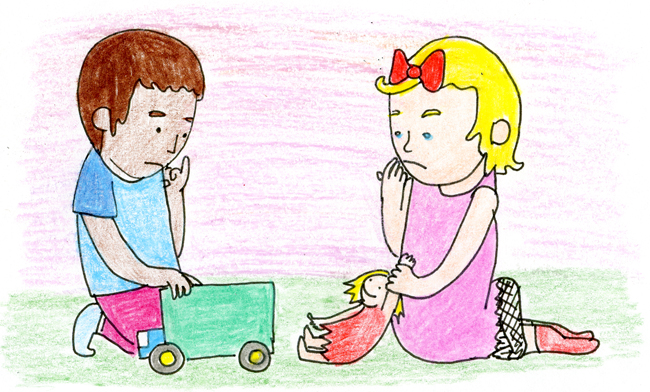The triplewart seadevil can grow to 44 centimeters long, according to FishBase, but no male of the species exceeds 7.3 centimeters. The male finds a female seadevil, attaches himself to her and impregnates the fish while parasitically sucking away her nutrients. Human men and women may sometimes seem like they’re worlds apart, but, compared to the seadevil, they’re really not all that different.
These differences arise early on. It’s more or less accepted that boys like playing with toy cars and girls with dolls, but what’s unclear is whether this comes about naturally or through cultural indoctrination. We’re nowhere near answering that question — if that’s even possible — but scientists have done research to get a better idea of the situation. By looking at babies — the younger, the better — researchers can uncover hints about whether these sex-based differences are innate or developed.
The go-to research task involves infants choosing between a toy truck, generally considered a boy’s toy, and a doll, a girl’s toy. Some of the most recent tests do this by tracking eye movements to determine which of the two the babies spend more time looking at. And, across multiple studies, the results are consistent: Girls spent more time looking at the doll than boys did. Likewise, boys spent more time fixating on the truck than girls did.
But here’s where things break from intuition. Even though the boys spent more time looking at the truck than the girls did, they didn’t necessarily look at it more than they did the doll. Indeed, the youngest baby boys tested seemed to prefer the doll — just not as much as the girls did.
This is baffling because it’s unclear as to what exactly the babies are responding. In the researchers’ efforts, they managed to eliminate many of the obvious possibilities. Boys and girls prefer the same colors, on average, so that can’t be it. They also don’t have any major differences in the kinds of shapes they like, so the effect didn’t come from girls preferring the rounded edges of the doll, either. But once they’re old enough to use crayons, girls tend to draw in a more rounded fashion, compared to the angular nature of what boys produce.
To make things even more bizarre, researchers produced the same effect when testing male and female monkeys of at least two different species. It turns out boy monkeys like toy trucks more than girl monkeys do.
But what does this all mean? Maybe not a whole lot. The results are all averages: Girls tend to look at the doll more than they do the truck, but individual girls didn’t. In fact, the results varied wildly from child to child, with some unable to produce any data in portions of the experiments because of a compounding variable that the researchers describe as “fussiness.”
While the results may be statistically significant, they aren’t necessarily meaningful. When given the choice between the two toys, baby girls still spend over 40 percent of the available time looking at the truck on average.
Throughout all of this, the elephant in the room is the issue of gender itself. The experimenters, for the most part, treat it as a definitive and absolute label, but that’s not quite right. Yes, there are men and women, but there’s also a lot in between, and these studies slide the issue of transsexuality under the carpet. There’s more to masculinity or femininity than the genitals one is born with, and there are plenty of men initially labeled as girls, as well as women initially labeled as boys.
This makes things even more complicated when looking at gender, which is already confusing enough when we think of male and female as the only options.
While these studies may shed some light on the differences between two groups of people, they’re unlikely to contradict the obvious: We’re all individuals. Gender is certainly an important part of someone’s identity, but it’s still only a part of it.















